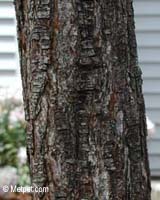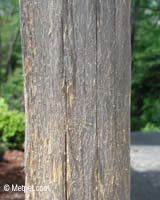Scratching Posts for Cats: Structure
Introduction to Cat Scratching Posts
MetPet.com Staff Writer
Cats will use a variety of
structures as scratching posts. The structure must be suitably
tall or long, be sturdy and have a pliable surface. Although they
are typically vertical, scratching posts can be horizontal or
slanted. Most cats prefer some variety and some busy cats
will scratch every available surface in the area.
A structure that is 3' tall or greater, about
the length of a cat standing upright on his back legs and
stretching up with his front legs, makes stretching easy.
It's hard to imagine a structure that is too tall.
A structure that is 6" wide or greater, about the width of his
shoulders, allows him to scratch a single flat surface with both
paws at the same time. Narrower structures such as small
trees, signposts or fence pickets can be grabbed around with both
paws and, while not as satisfying, will also do the trick.
A structure that has long, vertical and narrow
furrows that cats can run their claws along is very helpful as are
surfaces that are pitted with tiny crevices and holes.
Try it yourself
To get an even better idea of what your cat is looking for, try
this easy experiment:
Take a chopstick, sturdy pencil or pen with a narrow tip or even
unbend a paperclip. Dip the end in glue, paint or nail
polish and let it dry.
Now try to remove the dried glue, paint or nail polish by pushing
it into a hard, flat surface such as tile or plastic or a soft
surface such as dirt. Now try pushing it into and through a
pliable surface such as rough tree bark. It is not a perfect example but it will give you
an idea of what your cat goes through when maintaining his front
claws.
Out of doors
Indoor/outdoor cats find trees, fence posts, sign posts, gates,
doors, decks and most other permanent wood structures very
appealing as scratching posts.
Not
right
A hard surface such as this
metal signpost won't do as
claws can't penetrate it. Cats will leave this for the dogs to
use as their own bulletin board.
Although this small tree trunk
looks promising, the bark
comes off too easily so claws can't get any serious purchase. The
wood below is also surprisingly hard and slick as well.
Acceptable
but not perfect
Deck posts are sturdy, wide, flat and will likely get the once
over from your curious cat if they are easily accessible from the
ground. If the surface is slick, smells strongly of waterproofing
chemicals or is too hard, they will look elsewhere.
Trees with low hanging branches make the trunk difficult to
access. In addition, the sap from trees like this evergreen can
also discourage cat scratching.
  |
Just
right
This sturdy medium-sized
tree trunk, securely fastened into the ground by deep roots is a
nice choice. Although the wood underneath is relatively hard, the
rough and sturdy bark has enough grooves and pockets to catch and
hold onto a claw.
The split rail fence post is another good choice. The base is set
firmly into cement and the post is already furrowed and slightly
shredded to begin with. The post is even better than the tree
trunk since it clearly shows signs of use: hanging bits of wood,
deep grooves and other obvious signs of claw damage will invite
other cats to investigate further.
Related
information:
Scratching posts for cats: Overview
|
